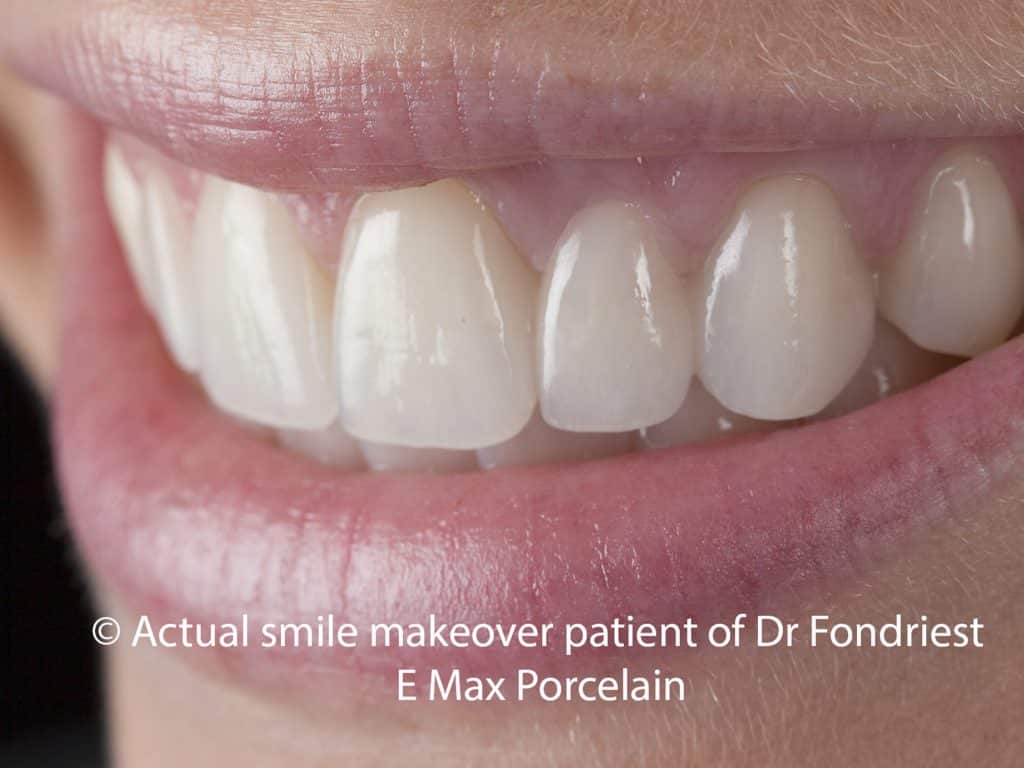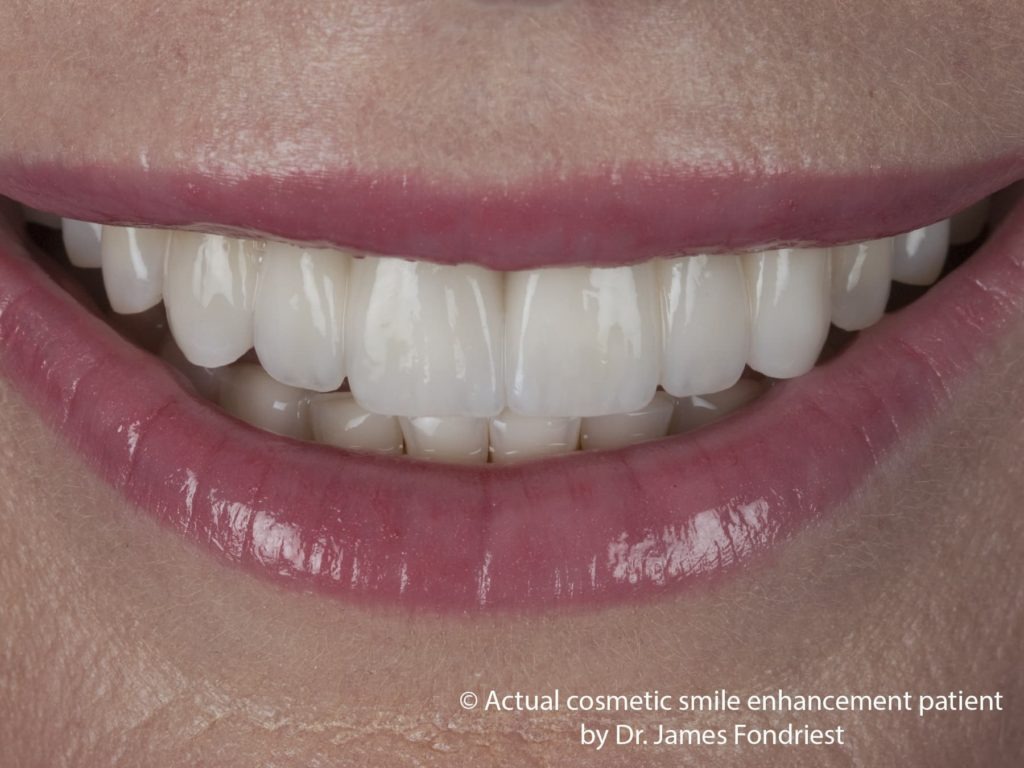Replacing missing teeth with a bridge

This patient was missing her left lateral incisor (second tooth from the midline). She preferred not to have an implant and wanted to know her alternatives. We made an all porcelain type of dental bridgework to bridge the gaps for her. Special attention was given to making it appear like a natural tooth growing out of the gum. Matching the surface textures and optical characteristics of the other natural teeth was also a challenge.
A dental bridge is commonly used to replace missing or lost teeth. This restoration can appear just like natural teeth. A traditional bridge can be made to appear as though the tooth was never lost. They are done as an alternative to dental implants.
Advancements in design techniques have increased our ability to make it look as though nothing ever happened. Dr. Fondriest works with his favorite ceramist to achieve amazing results.
WHAT IS A DENTAL BRIDGE?
Tooth bridges are used to replace a missing tooth or teeth. When a tooth is missing, the adjacent teeth on either side of the gap are employed to hold a false tooth called a pontic. The supporting teeth are called abutments. The abutment teeth are covered with crowns and these crowns support the false tooth called a pontic.
They are attached to the adjacent teeth or to dental implants next to where the tooth once stood.
The spaces left by missing teeth can cause the adjacent teeth to move or shift. This can result in the bite changing. Bridgework helps prevent this bite collapse from happening.
Dental bridge types

Our clients love to look at dental bridge pictures and guess which tooth is artificial. This patient was missing her upper lateral incisors with inadequate space for implants. The upper front 6 teeth were all part of an all ceramic fixed bridge. See the before treatment dental bridge picture.
There are four types of dental bridges:
1) All Porcelain
Permanently cemented types of dental bridges can be made out of many materials. All porcelain versions are easier to make lifelike. The technology behind porcelain bridgework is evolving quickly.
There are two main types of ceramics being used today, E max and zirconium. These porcelains are being used for teeth crowns also.
Zirconium bridges are growing in popularity for replacing natural teeth. This is the strongest of the ceramics and the esthetics can be phenomenal.
2) PFM: Porcelain supported by a metal substructure

Dr. Fondriest was able to replace the missing front teeth of this high profile Chicago attorney with permanent tooth bridges, giving her a uniform and radiant look.
A PFM bridge is the strongest type of dental bridge. This bridgework has a metal framework that reduces flexing from chewing and bruxism.
Under heavy loads, the top layer of porcelain can chip or fracture off of any type of bridgework. Porcelain has the same properties as glass. It has a low tensile strength and will crack, chip, or break easily.
The patient rarely is advised of the choices being made on their behalf. These choices determine bio-compatibility, tissue health, and longevity. The metallic frameworks are created in the lab with different quality levels of metal alloys.
A non-precious metal will not fit as well and will not be as bio-compatible as gold. Dr. Fulreader always chooses a very bio-compatible “high noble” precious alloy made primarily of gold.
Both the all porcelain and the PFM versions serve well on implant supported bridges. There are also two more less mainstream types that can be used in certain circumstances
3. Cantilever Bridge

The right lateral was congenitally missing and a PFM bridgework was employed to replace it. The false tooth (ovate pontic) was made to look as though it was growing out of the gum ridge. This patient wanted us to put all of the normal surface textures and micro-blemishes found in normal natural teeth. See the before treatment dental bridge picture of this Gurnee resident.
The cantilever version is like 2/3 of a normal bridgework. It has a false tooth supported only on one side. The support tooth is called an abutment tooth. It is hanging out in spaces and therefore introduces leverage on the supporting abutment tooth.
This type of bridge is NOT RECOMMENDED for use in the back teeth. This is an option best used for a missing front tooth. The bite forces are less in the front teeth and will be less likely to hurt or dislodge the bridgework.
4. Maryland Dental Bridges
This version has a false tooth supported only by two metal or ceramic wings projecting out from the sides of the false tooth. The wings are fitted to adapt to the backsides of the proximal teeth, also called abutment teeth. At delivery, the wings are bonded to the abutments.
A Maryland bridge is used mostly for young adults who have not finished growing and are considered too young for a regular version or an implant. These resin bonded bridges are viewed as a temporary bridge solution until adulthood as the strength is limited. These are usually only used to replace front teeth.
How to clean bridgework for optimal oral health
Maintaining good oral hygiene of your new dental work is just like caring for natural teeth. The American Dental Association recommends brushing twice a day and flossing once. Follow this link for advanced advice on cleaning your bridges.
This service description is not a substitute for advice, diagnosis, or treatment from your dentist.
Drs. Fulreader and Fondriest are Nationally recognized and highly sought after cosmetic dentists serving clients from throughout the United States
